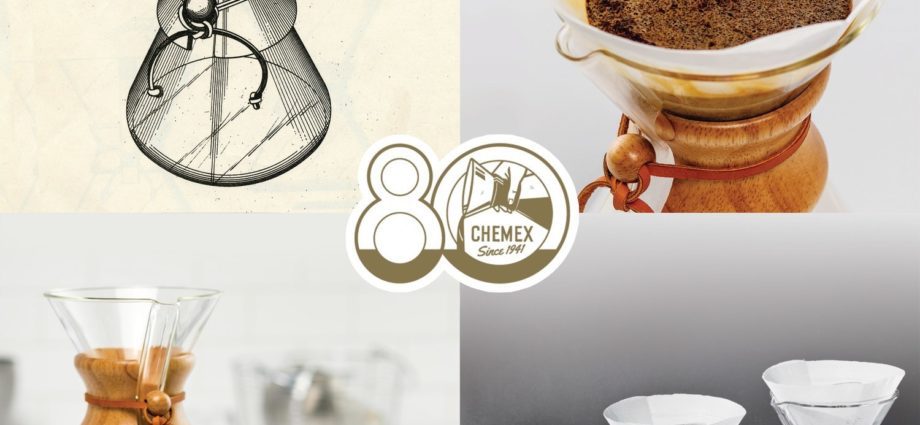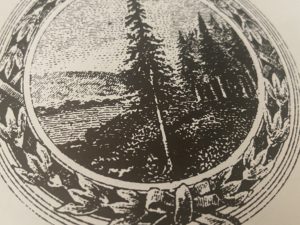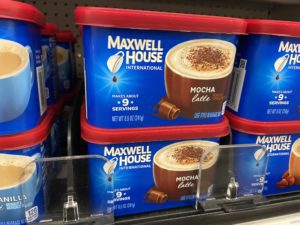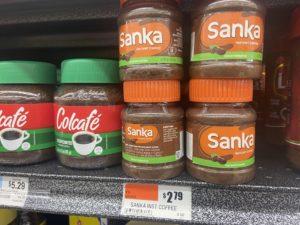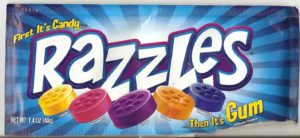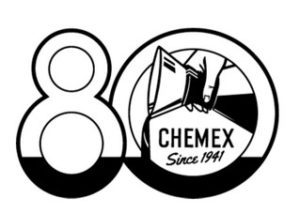
CHICOPEE, Mass. – The Chemex drip coffee maker, that perfect symbol of 20th century product design, celebrates its 80th anniversary this year. The coffeemaker, created in 1941, is still made in the U.S., by a family owned company.
The product is deceptively simple, namely an X-shaped beaker. The beaker has a paper filter for grounds, with the hotness of the glass relieved by small wooden pieces on the side, tied with boot string. The design also has a feature that allows it to pour without spilling, through a small gutter on the side.
Chemex assembled a history timeline of the eight decades on their website, where you can see every step of the history of the product. As part of the anniversary, they are selling a limited edition hand blown Chemex.
Prolific Inventor Schlumbohm
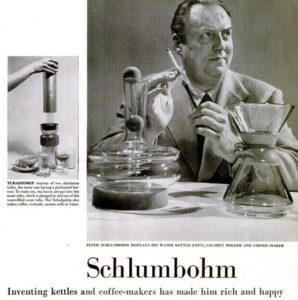
The Chemex was invented by Dr. Peter Schlumbohm, a German-born scientist with dozens of other patents (see bottom of story). The mid century was a time of notable product design and designers, from Eero Saarinen, Raymond Loewy and Charles and Ray Eames, among many greats. The Chemex was always considered a high design, museum quality item. But Schlumbohm was not a product designer. He was a chemist. He fit more in the manner of Earl Tupper, inventor of Tupperware. In the case of Dr. Schlumbohm, he had to find a problem and it was then that he tried to invent a solution.
He also had a knack for Wonka-like marketing and clever names for products including the Minchaha cocktail shaker, Farenheitor, Tubadripdrip (brewed tea and coffee) and Tempot, an unmechanical washing machine.
A 1949 Life magazine profile story put it well:
When a design proves itself and looks right, he has a draftsman draw up blueprints. He farms out the manufacture of the various components to such companies as Alcoa and Corning Glass. They are then assembled by eight strong backed women in a small factory in lower Manhattan. Dr. Schlumbohm does all his own selling, writes his own advertisements, direction leaflets and brochures and even types out his own patent applications–one draft only since he refuses to make a mistake.
Life Magazine, 1949
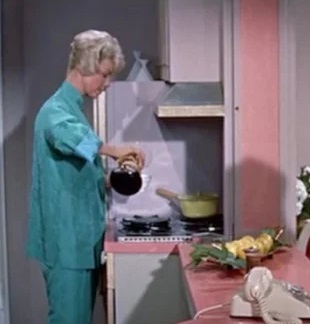
At the time of its invention, the typical way to make coffee (other than in a pot) was in a coffee pot or a stove top percolator, which in some cases cooked the grounds too much. Growing in popularity as appliances got cheaper was the electric percolator.
The Chemex was not the only non-electronic way to make coffee with good design. There was the metal Melior. And Corning had a number of versions, including a full glass percolator, and the Corning Pyrosil, which was white with the Corning blue corn husk on the front.
The Chemex became the precursor to the drip coffeemaker, though it had no moving parts. Dr. Schlumbohm’s design could be used in the laboratory, hence the name Chemex. He patented hundreds of inventions. Of the more prescient was the glass cigarette holder with a filter, before filtered cigarettes became the custom.
It gained fame in the 1950s, when it was part of the whole modern movement. And it became an accessory in movies. For instance, Doris Day, playing an interior decorator to Rock Hudson, uses one in her kitchen. And even appears in Ian Fleming’s From Russia With Love. Wrote Fleming:
It consisted of very strong coffee, from De Bry in New Oxford Street, brewed in an American Chemex, of which he drank two large cups, black and without sugar.
From Russia With Love, Ian Fleming
Dr. Schlumbohm had dozens of other inventions, many that were as elegant as the Chemex. However, the Chemex brand had a special lure. It was first put on the market in 1941, at the beginning of World War II. Because it had no parts, and needed no special materials for wiring, it was a perfect item for a time of materials and consumer products rationing. Made of wood, leather, and glass/sand, there never would be a shortage of materials.
Below is how Dr. Schlumbohm describes the Chemex.
This invention relates to a filtering device and more particularly to a cofee maker and tea maker. Though the filtering device to be described may be used with facility in the making of coffee and tea, it is not-limited to such use and may be generally used in the laboratory to effect filtering processes. The filtering device is a combination of a filter funnel adapted to hold a paper filter and a bottle-like flask adapted to receive filtrate. These two elements are formed integral with each other or are joined to form a single element.
From the introduction to U.S. Patent 2241368A
Always, Schlumbohm was careful to think about his ultimate customer, the post World War II housewife. The paper was the invention, too:
After the ground coffee has been extracted by the hot water the filter paper which holds the spent coffee grounds is taken out of the funnel by simply gripping the rim of the paper at opposite sides with both hands, lifting the same from the funnel whereupon it may be disposed of in the ordinary garbage receptacle. This is a great convenience to the housewife, who in the past has been accustomed to untidily disposing …. a one piece filtering device of simple, construction which may be readily cleaned and used with facility.
U.S. Patent 2241368A
Below, more about the patent. At bottom, his detailed patent for a carafe with a handle around the middle.
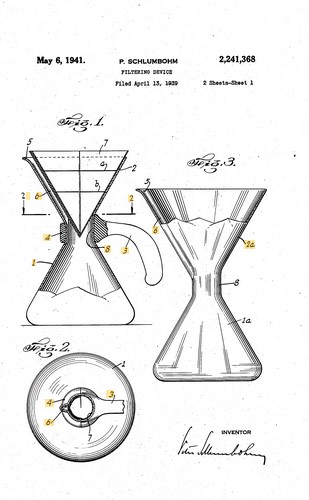
“It will be obvious to those skilled in the art that various changes may be made in this device without departing from the spirit of the invention and therefore the invention is not limited to what is shown in the drawings and described in the specification…”
Dr. Peter Schlumbohm, in his Patent Application
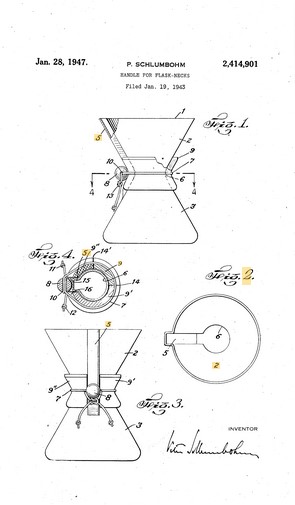
Here is how he describes a separate invention, the flask that is able to be poured easily with a wooden neck grip. Quite beautifully written:
The handle which I invented has proved so practical, that its application will not be limited to coffee-maker bowls, but will have general practicability for a flask which is suitable for a neck grip.
Flasks, which are designed to be gripped by the neck, all have one feature in common: The neck constitutes a restriction in diameter not only computed on the diameter of the flask body below the neck, but also computed on the pouring mouth above the neck. The pouring mouth either has a thickened edge, or is flared, or has a protruding pouring lip or is funnel-shaped as in the example given in the drawing.
In addition to the requirements which dictate a widening of the diameter of the flask-mouth over the diameter of the flask neck, there will also be the desire to create a restriction per se in the flask neck, so as to allow a better grip without slipping. To provide a heat-insulating handle for such a flask has been done in the well known manner of weaving a basket-like structure around the neck of a laboratory-flask.
Such basket technique is practically limited to handwork and its quality varies with the skill of the individual worker. The invention applies a barrel-technique instead of the basket method. The handle is built up from segments, like a barrel is built up from staves. These stave-like segments are assembled on the neck of the flask and subsequently bound with a hoop or a loop to form an entity.
Below, a video profile of the Chemex, and how they are put together:

